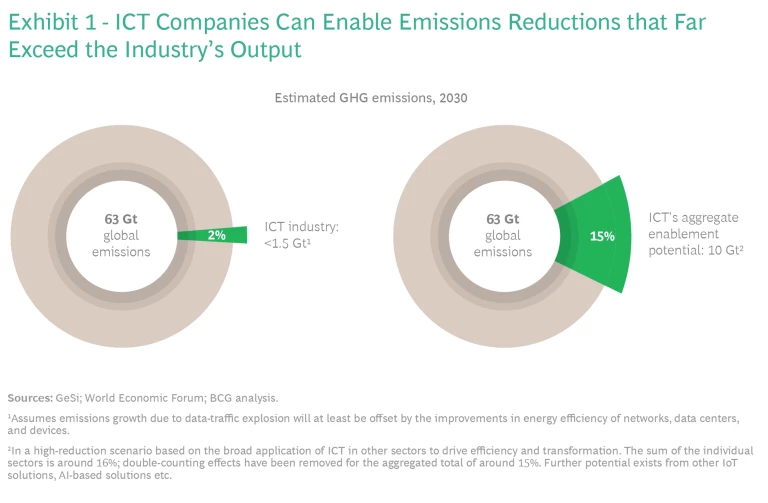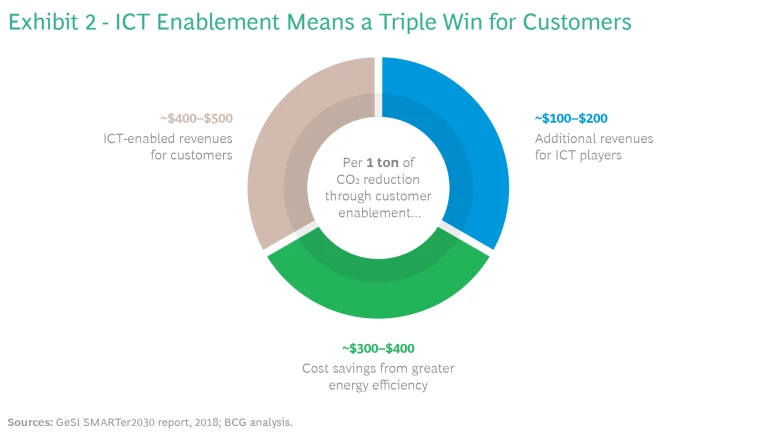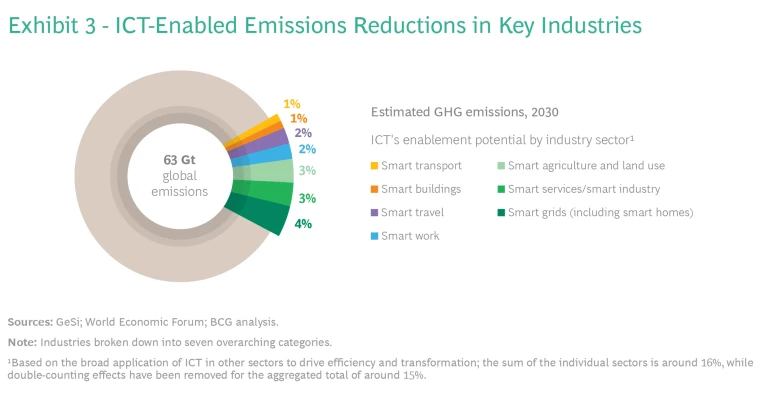Globally, companies in the information and communications technology (ICT) industry directly generate about 2% of the world’s total output of greenhouse gases (GHGs) every year—largely from the power needed to run its data centers, data networks, and the like. Yet the industry has already made enormous contributions to a more sustainable world. Digital technologies developed by ICT companies have significantly reduced GHGs in industries as varied as communications, travel, and industrial production.
That’s just the beginning. Thanks to current and future innovations in areas such as the Internet of Things (IoT), 5G cellular, artificial intelligence (AI), and big-data analytics, ICT companies have the potential to mitigate an additional 10 gigatons more GHGs through 2030. How? By enabling their customers to reduce emissions through the products and services the industry sells—not just the information and analytics systems offered by technology companies but also the connectivity services and associated digital services provided by the telecom sector.
From oil and gas and industrial production to food and agriculture, health, education, and buildings and construction, companies can use ICT technologies to reduce emissions by improving efficiency, reducing energy use, raising productivity, replacing physical processes, and allocating resources more effectively. In helping fight global warming, the ICT industry’s enablement efforts will also lower customers’ energy and carbon tax costs and increase their revenues through greener products—and bring in up to $2 trillion in top-line growth for the ICT industry.
That’s a win-win-win for all concerned. Here’s how to capture it.
Scoping Out the Challenge
Of the approximately 1.5 gigatons of GHG emissions the ICT industry is directly or indirectly responsible for today, about a third are Scope 1 and 2 emissions. The rest—about 1 gigaton, or between 65% to 75% of the industry’s total—is comprised of Scope 3 emissions, which include the upstream emissions emitted by companies from which the industry buys goods and services and the downstream emissions generated by ICT customers as they use and dispose of ICT products.
The industry is already working to reduce all three types of emissions—by becoming more energy efficient, using more renewable energy, working with its suppliers to produce their goods more efficiently, and developing goods and services that consume less energy as customers use and discard them responsibly.
But there is a far more important role for the ICT industry to play in the fight against climate change: developing services that enable other industries to increase efficiency and reduce their own energy consumption, and thus their own Scope 1 and 2 emissions. This is the big prize—a fourth emissions scope, in effect—a total of about 10 gigatons of GHGs, or 15% of the global total of 63 gigatons expected to be emitted through 2030. (See Exhibit 1.)

Say, for example, that a technology company sells fleet-management software to a delivery company. The technology company creates Scope 2 emissions through the electricity it uses in creating and marketing the software, and it creates downstream Scope 3 emissions in the form of the electricity the delivery company consumes in using the software. Now assume that in using the software, the company’s fleet of vans uses 30% less gasoline, reducing its Scope 1 emissions by 25%.
This has to be balanced against the presumed increase in the delivery company’s Scope 2 emissions from using the software and the increase in its upstream Scope 3 emissions by having bought the software from the technology company—let’s say that’s 5%. As a result, the net total of reduced emissions the ICT product has enabled comes to 20%.
In short, across industries, new information and communications technologies will mean significantly lower energy consumption—and thus emissions reductions of at least 2 gigatons annually through 2030, according to the Global Enabling Sustainability Initiative (GeSI)—as well as the use of less fuel and other inputs. And reduced energy consumption will get ICT customers closer to their own carbon reduction targets, which will further benefit them through the lower cost of capital and lower carbon-tax costs, for example.

Moreover, 70% of consumers are open to a 5% pricing premium for green products, according to the Maersk Mc-Kinney Moller Center. This, together with increased market share, suggests that these industries’ sustainable new products and services will also considerably enhance the top line—by an estimated $400 to $500 per ton of GHGs reduced, according to the GeSI. (See Exhibit 2.)
The benefits for ICT companies are equally impressive. Products and services that offer customers greater sustainability mean significantly increased revenue potential—an estimated $100 to $200 per ton of GHG emissions reductions enabled through 2030. Such products also improve client relationships and loyalty and enable premium pricing. And a sustainable image can improve ICT companies’ reputation and competitive positioning.
Taken together, our analysis indicates that customer enablement will lead to considerably greater revenues for both ICT’s customers and the industry itself, as well as cost savings in the form of greater energy efficiency.
Industry Opportunities
ICT companies have opportunities to apply customer-enablement measures to companies in virtually every industry (see Exhibit 3). Five industries stand out:
- Energy. The ICT sector can enable the integration of renewables into the power grid, improving efficiency and heightening transparency. Smart grids, analytics solutions, and advanced energy management systems can abate 1.8 gigatons of CO2 equivalent (CO2-e) through 2030 and generate new revenue opportunities for the sector.
- Buildings. New technologies will increase comfort and reduce energy and water bills—cutting around 2 gigatons of CO2-e from the global housing sector, reducing energy costs, and creating further revenue opportunities.
- Food and Agriculture. New so-called agtech systems can boost yields by 30%, avoiding 20% of food waste. Such systems could also reduce the industry’s water usage by 250 trillion liters of water and abate 2 gigatons of CO2-e.
- Mobility and Logistics. New technologies can help people and goods reach their destinations faster, safer, and cheaper, abating 3.6 gigatons of CO2-e (including abatement from avoided travel through real-time traffic information, smart logistics, intelligent lighting, and other ICT-enabled solutions).
- Manufacturing. ICT will place the customer at the center of a user-focused service, cutting resource inputs at the same time. Smart manufacturing solutions alone—including virtual manufacturing, customer centric production, circular supply chain and smart services—could abate 2.7 gigatons of CO2-e.

Companies in these and other industries can use ICT technologies to realize other benefits as well. One large US retailer partnered with a manufacturer of irrigation controls to develop an integrated and carefully tailored IoT solution to create smart irrigation controllers. The system enabled the retailer to reduce annual water usage at its retail sites by 650 million gallons overall, saving the company $5 million a year—while also reducing its CO2-e emissions by 750 metric tons annually.
Enabling Customer Enablement
Already some ICT companies are developing dedicated products and services designed to help their customers reduce emissions through a variety of technologies. To fully capture the opportunity, however, ICT companies will need to take an approach that makes maximum use of the digital services they already offer while building a strong portfolio of new ones.
Repurposing Current Offerings. Many ICT companies already have services in their portfolio that help other companies to reduce their consumption of energy and other resources. An example might be a home-office solution that enables employees to work efficiently at home and avoid the daily drive—even if the service was developed primarily with the intention of increasing workers’ efficiency and improving their work-life balance. Similar services could include IoT solutions that allow customers to reduce the cost—and emissions—of fossil-fuel-powered physical travel, such as remote maintenance services.
To ensure that customers understand fully a service’s enablement benefit, it should be sold with a transparent explanation and calculation of the service’s emission history and emission future, showing what it will mean for the customer’s Scope 3 upstream and downstream emissions, as well as the emissions-reduction potential. Otherwise, the customer cannot really calculate the full emissions impact of using this service. To that end, every service should be sold with a calculation tool allowing customers to easily calculate the emission reduction the service offers.
As companies strive to deliver on their emission reduction targets, they will need more and more digital solutions to help them reduce their emission footprint. Many services that were not seen as affordable will likely become more attractive as energy and carbon costs rise, and with them the cost of abating GHG emissions. Higher revenues, greater customer loyalty, and reputational advantages can further offset the costs of these sustainability services.
Green Venturing. It may be that developing digital sustainability solutions is not close to the core of an ICT company’s business. A company that focuses on the automotive sector, for example, may struggle to develop a smart solution for the agriculture industry. In such cases, companies should consider “green venturing,” which would allow them to focus on new sustainable services and business models without distracting them from their core business. At the same time, companies must create synergies between their core business and the new green venture that give it an “unfair advantage” in the market, and thus the right to win—while also providing the independence it needs to scale up.
Optimized Development. As valuable as digital sustainability solutions can be in reducing end-user emissions, the process of creating them generates its own emissions—in addition to the emissions generated as customers use them. Optimizing both these Scope 2 and Scope 3 emissions sources has so far not been the focus of product development for many ICT companies; going forward, ensuring that their own emissions are as low as possible should be a design principle for every ICT company’s product-development efforts. By demonstrating meaningful, measurable progress toward their own net-zero goals—including reductions in Scope 3 emissions—they can more credibly sell sustainability solutions to their customers.
Stay ahead with BCG insights on technology, media, and telecommunications
The Go-to-Market Framework
In preparing a portfolio of customer-enablement offerings to take to market, ICT companies need to begin with the connectivity products they already offer and work collaboratively across departments to ensure that the products are ready for the market. To get these products to market fast, companies should consider working within a three-step framework:
Benchmarks and Starting Point. Determine the vision and overall ambition for the customer-enablement program, benchmark competitors’ enablement offerings to gain insights into the nature of the market, and evaluate the demand for enablement products by industry sector. Then invest heavily on delivering just a few strong products with demonstrable mitigation potential and that match the ICT company’s strengths and customer concentration. Clarity of focus is key; without it, companies are all too likely to hedge their bets and create a range of mediocre products.
Impact Quantification. The goal at this stage is to fully quantify the extent to which specific enablement solutions can mitigate each potential customer’s carbon emissions. This will require a full understanding of customers’ current emissions profile and careful calculation of the new offering’s impact. These emissions calculations must be rigorous and defensible, given the high level of skepticism in the market regarding such efforts, and ICT companies that are strong on data analytics can excel in this regard; at the same time, the ICT industry as a whole needs to accelerate its efforts to develop standards for the reliable quantification of the decarbonization impact of its offerings. This stage should also allow ICT companies to improve on their offerings’ ability to mitigate emissions.
Go-to-Market Cornerstones. This is the stage at which ICT companies prepare their offerings for the market. Here, the mitigation analysis must be aligned with independent external standards and then incorporated into marketing efforts. Specific proposals should include well-defined, sustainability-related narratives and calculators allowing targets to determine how each offering would affect their own results.
The ICT sector has a great deal to contribute to global efforts to mitigate GHG emissions and slow the effects of climate change. The products and services they already offer, and the innovative solutions now being developed, can greatly increase efficiency and reduce energy consumption across almost every industry—while boosting the sector’s own revenues at the same time.
That’s a triple win: for the environment, for the industries enabled, and for the ICT sector itself. The key is collaboration, and an understanding that the time to begin capturing all these benefits is now.




